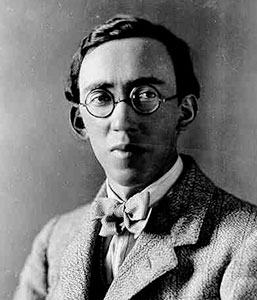
Vernon March (1891–1930) was an English sculptor, renowned for major monuments such as the National War Memorial of Canada in Ottawa, Ontario, the Samuel de Champlain Monument in Orillia, Ontario, and the Cape Town Cenotaph, South Africa. Without the benefit of a formal education in the arts, he was the youngest exhibitor at The Exhibition of the Royal Academy of Arts.

The Old Steine Gardens in Brighton, Brighton and Hove, East Sussex, England, adjacent to the Old Steine thoroughfare, are the site of several monuments of national historic significance.

Elsie March was an English sculptor and one of eight artists in her family. After the death of her brother Vernon March, she and her brothers completed the National War Memorial of Canada in Ottawa, Ontario. One of the family's three sculptors, her focus earlier in her career was metalwork and painting.

Sydney March (1876–1968) was an English sculptor. His primary focus was portrait busts and other sculptures of British royalty and contemporary figures, as well as war memorials. The second-born of eight artists in his family, he and his siblings completed the National War Memorial of Canada after the death of their brother Vernon March in 1930, who had created the winning design. It is the site in Ottawa of annual Remembrance Day ceremonies.

The Bromley War Memorial in Bromley, Greater London, England commemorates the fallen of World War I and World War II. It was designed by British sculptor Sydney March, of the March family of artists.
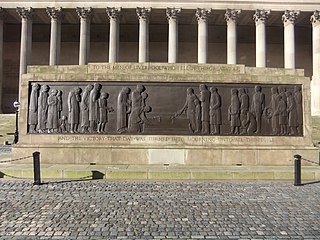
Liverpool Cenotaph stands on St George's Plateau, to the east of St George's Hall in Liverpool, England. It was erected as a memorial to those who had fallen in the First World War. The dates of the Second World War were subsequently added. The cenotaph consists of a rectangular block of stone on a stone platform, with bronze, low-relief sculptures on the sides depicting marching troops and mourners. It was designed by Lionel Budden, with carving by Herbert Tyson Smith. Initially designated as a Grade II listed building, its status was raised to Grade I in 2013.

Widnes War Memorial stands in Victoria Park, Widnes, Cheshire, England. It commemorates the serving men who lost their lives in the two world wars. The memorial consists of an obelisk in Portland stone on a plinth of York stone. It was unveiled in 1921, and more names were added in 1950. The monument is recorded in the National Heritage List for England as a designated Grade II listed building.

The statue of the Earl Kitchener is an outdoor bronze statue by John Tweed depicting Herbert Kitchener, 1st Earl Kitchener, installed in 1926 and located on the south side of Horse Guards Parade in London, United Kingdom. The sculpture stands on a Portland stone plinth. It became a Grade II listed building in 1970.

A bronze statue of Admiral of the Fleet Louis Mountbatten, 1st Earl Mountbatten of Burma is located on Mountbatten Green, off Horse Guards Road, Whitehall, London, England. The sculptor was Franta Belsky and the work was cast by the Meridian Bronze Foundry. The memorial was unveiled on 2 November 1983.

The London Troops War Memorial, located in front of the Royal Exchange in the City of London, commemorates the men of London who fought in World War I and World War II.

The Portsmouth Naval Memorial, sometimes known as Southsea Naval Memorial, is a war memorial in Portsmouth, Hampshire, England, on Southsea Common beside Clarence Esplanade, between Clarence Pier and Southsea Castle. The memorial commemorates approximately 25,000 British and Commonwealth sailors who were lost in the World Wars, around 10,000 sailors in the First World War, and 15,000 in the Second World War. The memorial features a central obelisk, with names of the dead on bronze plaques arranged around the memorial according to the year of death.

The Boer War Memorial is a heritage-listed memorial at Warwick Street, Allora, Southern Downs Region, Queensland, Australia. It was built from 1904 to 1940s. It is also known as Queen's Park and War Memorial Park. It was added to the Queensland Heritage Register on 21 October 1992.
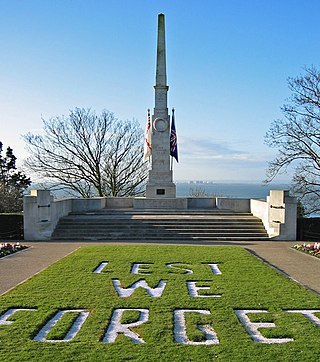
Southend-on-Sea War Memorial, or Southend War Memorial, is a First World War memorial in Southend-on-Sea, Essex, in south-eastern England. It was designed by Sir Edwin Lutyens and unveiled in 1921. Southend-on-Sea is a seaside resort famous for its pleasure pier, which was used by the military during the First World War. The town was a stopping point for soldiers en route to the front and, as the war drew on, several buildings in Southend were converted into hospitals.
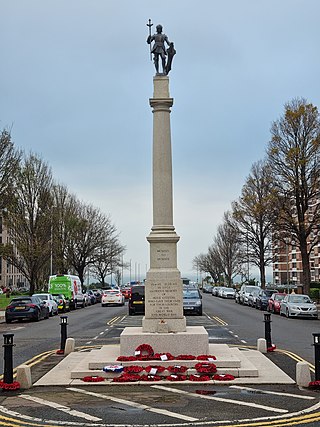
Hove War Memorial is a First World War memorial designed by Sir Edwin Lutyens and located on Grand Avenue in Hove, part of the city of Brighton and Hove, on the south coast of England. Hove was the site of one of the earliest recruiting events at the beginning of the war and later of several military hospitals. Over 600 men from the town were killed during the war, a quarter of them from the local regiment alone. A war memorial committee was established in 1919 and Lutyens was engaged as architect. A design was agreed in 1920 after two unsuccessful proposals; Lutyens chose the site from several options.

Fordham War Memorial is a First World War memorial in the village of Fordham in Cambridgeshire in eastern England. The memorial was designed by Sir Edwin Lutyens with sculpture by Sir George Frampton and closely resembles Hove War Memorial in East Sussex, which was also a collaboration between Lutyens and Frampton. It was unveiled in 1921 and is today a grade II listed building.

Runcorn War Memorial was built to commemorate the servicemen of Runcorn lost in active service in the First World War. It was unveiled on Remembrance Sunday 1920 at 3:30pm, beginning a tradition of afternoon services. In 1948, the memorial was rededicated and the names of those lost in the Second World War were added. An inscribed stone was added later with the names of those lost in subsequent conflicts.

The Royal Artillery Boer War Memorial is located on the south side of The Mall in Central London, close to the junction with Horse Guards Road at the northeast corner of St James's Park. Unveiled in 1910, it marks the deaths of the 1,083 soldiers of the Royal Artillery who died in the Second Boer War from 1899 to 1902 It has been a listed building since 1970.

The Dulwich Old College War Memorial is located in the forecourt of Dulwich Old College on College Road in Dulwich in the London Borough of Southwark. It marks the deaths of the former pupils of the college who died in the First World War between 1914 and 1919. The memorial is made from Hopton Wood stone and was designed by William Douglas Caröe. It was unveiled in 1921. It has been grade II listed on the National Heritage List for England since May 2010. The heritage listing places the memorial within a "visual and contextual relationship" with the Grade II listed Old College building and the entrance gates and piers of the Old College, also Grade II listed.

A bronze statue of General Charles George Gordon by Hamo Thornycroft stands on a stone plinth in the Victoria Embankment Gardens in London. It has been Grade II listed since 1970. A similar statue stands at Gordon Reserve, near Parliament House in Melbourne, Australia, on its original tall plinth.
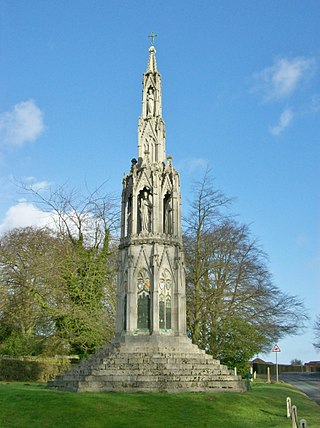
A replica Eleanor Cross was erected in Sledmere, East Riding of Yorkshire, in 1896–98. The tall stone structure was constructed by the Sykes family of Sledmere. Engraved monumental brasses were added after the First World War, converting the cross into a war memorial.

























